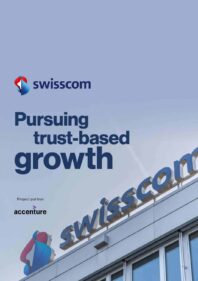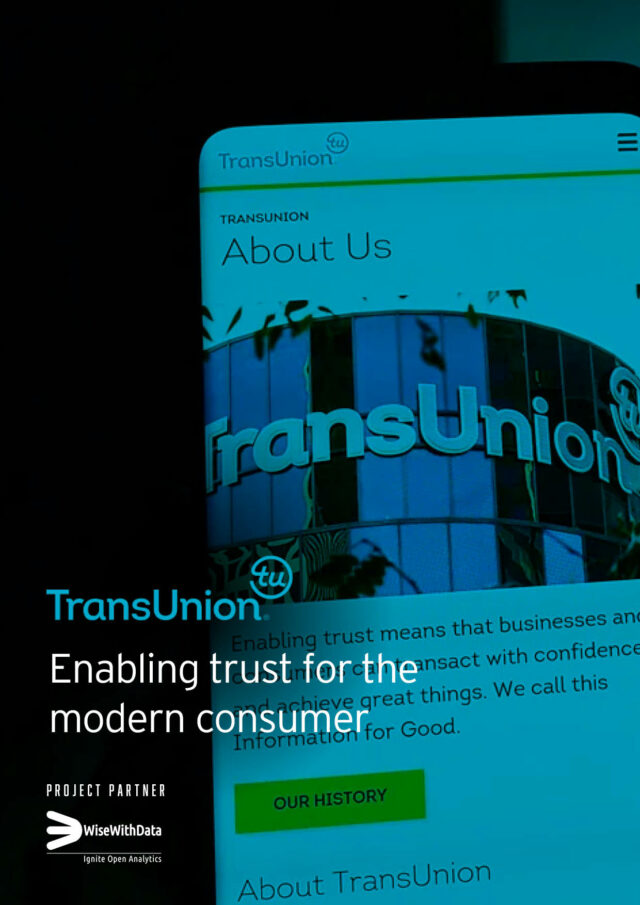
In June 2020, Interface Magazine published an in-depth feature on telco giant Swisscom’s new omni-channel platform – created in conjunction with Accenture – which transformed Swisscom’s B2C offering. Accenture delivered the framework for this digital omni-channel platform (DOCP) and, over time, Swisscom was able to run it independently. In the story, we mentioned that the company was also planning a B2B transformation. At the time, the plan was in its infancy.
Now – again, hand-in-hand with Accenture – Swisscom launched this exciting new element of its business. We spoke with three people directly involved with this next step – Stephan Schneider, MD of Accenture; Anne-Thérèse Morel, Head of Capability Management at Swisscom Business Customers; and Matthias Piller, Solution Train Engineer at Swisscom – to gain a broader insight on what has changed since our last catch-up.
Customer-centricity
Let’s start off with what hasn’t changed: customer centricity. That has remained the focus with both the B2B and B2C digital transformation projects, because customer needs are ever-changing and cannot be overlooked or underestimated. “In their private lives, customers are used to interacting digitally,” says Morel, “and everybody expects everything to always be working. The telco industry has to evaluate everything based on these market changes, as do big IT companies. These changes in the industry bring new risks, but also new opportunities. We felt this was the right moment to start the B2B transformation; we had a chance to get it done, now.”
A major element to consider when slotting together the puzzle pieces for the B2B transformation was security – something the pandemic has highlighted more than ever before. “All companies, today, have to think about the security exposures we have, so this is really a USP,” Morel continues. For Swisscom, trust is integral, and part of the value proposition.
“As the saying goes, trust is the hardest thing to win and the easiest thing to lose,” says Schneider. “It’s important to customers of Swisscom but also between our partners – and within Swisscom itself. I think we’re really in this complete 360-degree relationship where everybody builds it together, and we grow based on that trust, and it makes us successful.”

The evolution to B2B
Swisscom already held a unique position in the B2B market, thanks in part to its existing work with B2C customers. The first consideration, when undertaking this shift, was facing the market conditions themselves, which included bringing together the split landscape of SME and corporate clients, assessing the opportunities available through the partner ecosystem, and understanding the competition.
In response, Swisscom began a journey to create a simplified, unified user-centric B2B hub. So exactly what does this improvement of B2B relationships, via technology, actually mean for Swisscom? Why was it a necessity? “Swisscom, as a B2B domain, has a really broad portfolio of services,” says Morel. “The challenge, today, is to have the availability to integrate these different services and to simplify and automate within the back-office.”
“We had the analytic ability to reduce complexity into simple blocks which we could then implement – something that’s really key in this setup,” Schneider adds. “We had a common goal in our relationship with Accenture, which was to take the core of our customer portal and apply it to partner interactions,” Morel says.
“We are aligned with Accenture in terms of road map and vision, and we have the flexibility to react to situations.” This agility was tested by COVID-19 of course, but thankfully, Swisscom’s digital transformation has occurred over the course of several years, so, fortunately – and thanks to that long-honed flexibility – the pandemic didn’t slow it down.
“The technology we have is also flexible, of course,” Morel continues. Swisscom had the architecture in place from its customer-centric and internal-based projects, making the expansion into B2B so much smoother – which bodes well for any new adaptations down the line. “I really believe that we have the correct architecture and mindset to tackle the digitization challenges of the future.”
“It helped us a lot that we did not had a fixed masterplan, but an agile and adaptable operating model. We were able to re-prioritize the features whenever we had changes in business priorities, including those caused by COVID,” Schneider continues. “But what we did have was a shared objective and the trust that we mentioned before. Incremental steps will guide you to a successful product. You need to accept that some will fail, but you will create the best solution, when every step is a learning experience.”

Complexities
It’s fortunate that Swisscom was prepared for the pandemic in terms of its advanced technologies and its flexibility, because COVID-19 forced digital services forward with an almighty shove. Swisscom had to provide consistent support, all while each team member was working remotely and the business was going through a transformation.
“I love solving complex problems, and it’s important that you have a solid team around you when tackling them, because digital transformation is like electricity – nobody thanks you when it works, but everybody is there to complain when it stops working,” Morel explains. Good customer experience looks always simple, but it’s complex to realise it, and it has its costs.
“Of course, when you have around 300,000 customers, you will find that, for a few of them, it will be difficult to find the right solution. A lot of communication is needed to make it in a way that is acceptable for everybody, so that, at the end, we add value for the customer.”
Accenture as a partner
A major part of why this flexibility has been possible is, of course, down to the relationship between Swisscom and Accenture. Before the pandemic, everybody was able to work together and have regular meetings in Switzerland, but the first lockdown put a swift stop to that. The B2B portal was in trial mode and Swisscom was having two-day planning sessions every 10 weeks to plan the following 10 weeks, so being unable to meet initially seemed like a serious problem.
“We were starting to work together for B2B beginning of 2020,” Piller says. “And we were forced to do it virtually from the beginning, which was not a problem technology-wise, but we were concerned about how it would work with 300 people involved. But everybody was in the same situation – including the Accenture team members, wherever they were in the world – and we looked at it as a chance for better collaboration. It was not an ideal solution, at the beginning, but it worked well and we haven’t lost efficiency along the way.”
For Morel, this way of working brought an additional level of maturity to the project, and Accenture still had the access to the Swisscom team that it needed to help it connect with the customer and develop its business understanding. “You have people who are speaking the same business language, and that helps collaboration and trust. Of course, we are not always on the same page when it comes to understanding a problem that comes up, but we have the ability to bring people to the table and talk openly about it, and say ‘we have to change something’.”
Data-driven transformation
It’s one thing saying that everything needs to be automated and digital, but for that to happen, a good, solid database is required. Transformation is not linear, but driven by the examination of data and new ways of using it to solve problems. “You have to have all your data about your customer, about your services, your contracts, and everything needs to be clean, consistent and complete,” says Morel. “It seems really easy, when you say that, but when you’re a large company with a long history, the data is not always compatible.”
Centralisation of information has been the key, here, in a way that is structured enough to evidence to the customer. Historically, this data was only used internally – now, with a digital strategy at the forefront of business, everything is visible. “It’s a huge amount of work, to get all the data in place,” says Morel, “but it’s a discipline that you need to introduce to your company – the understanding that your data needs to be clean and organised, because it’s needed for so many purposes. We’re still not at the end of this challenge.”

Agility
For Piller, the focus for Swisscom’s B2B transformation was always agility – the glue that holds everything together – and the vision was always to create a B2B portal once the B2C one was in place. “One of the biggest aims of the development value stream we decided to implement 16 months ago was to have this omni-channel portal also installed in B2B, which meant optimising a lot of the migrations we do. We took the old world and moved it to the new world.”
Examining the DOCP architecture provided by Accenture for a B2B focus, Swisscom realised it wouldn’t fit 100%, so some tweaking was required. Each decision was taken extremely carefully and the user experience was always at the forefront of the team’s minds. The B2B platform is, in Piller’s words, in “the ramp-up phase”, with around 250 customers using it at the time of interviewing. “We’re trying to bring in all SMEs, as well as the corp clients, on this solution. That’s the goal.”

While the ramp-up phase continues, Swisscom is doing what Piller calls “enhancement work”, where it continues to look closely at the requirements of its B2B customers – whether it’s a huge bank or an independent barber shop – and make sure it can cater to both successfully. “There is a big spread of requirements,” Piller says. “Our goal is to have this DOCP for all channels, and agile methodologies are helping us to get all of this done.”
While this latest project has been largely – and successfully – informed by the B2C model, there have been specific B2B challenges to overcome along the way. “The difficulty is everybody wants everything all at the same time, and they want it immediately,” Piller says. “When we started the B2C transformation, that was happening at the same time as our agile transformation, and it was so difficult – new technologies, new people, a new partnership we weren’t used to yet. It took a while to come together, and now, it operates like a well-oiled machine. So, with B2B, even with a framework largely in place, we knew we couldn’t do everything at the same time – you need to orchestrate, organise, cost things, and operate in an agile way, which is a super cool way of working that I’m passionate about.”

Swisscom culture
Part of the reason that agile working is so successful for Swisscom is the culture of free thinking that it promotes. While most people are used to a hierarchical way of working, the aim at Swisscom is that people think for themselves – something that has only become more prevalent and encouraged as the business continues to transform. And, unsurprisingly, this has been accelerated by COVID-19 and the rise of remote working. Piller himself is part of the crisis management team at Swisscom, alongside his usual role, and helped in the orchestration of a task force to deal with how the organisation would cope during the pandemic. He focused on decentralising a lot of tasks and projects and giving people more freedom and responsibility.
In these unprecedented times, Swisscom has managed to not only weather the storm, but successfully navigate to shore thanks to its future-orientated outlook and agility. And, of course, solid, trusting relationships with partners like Accenture.









